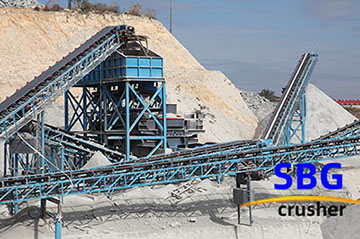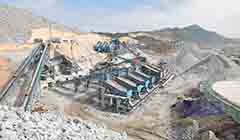
The movable jaw plate approaches the fixed jaw plate periodically to realize the functions of crushing, splitting, breaking, and impacting, thus to coarsely or mediumly crush materials with various hardness. It was invented by American E.W. Black in the 1850s. The specification of jaw crusher is expressed by the feed port width B and length L
 سؤال
سؤال 32;A primary jaw crusher is a machine designed to reduce large rocks into smaller rocks, gravel, or rock dust. It is used in many industries, including mining, construction, and demolition, to crush materials such as rocks, coal, and ores. A primary jaw crusher consists of two plates, one stationary and one movable, which form a V-shaped
32;A primary jaw crusher is a machine designed to reduce large rocks into smaller rocks, gravel, or rock dust. It is used in many industries, including mining, construction, and demolition, to crush materials such as rocks, coal, and ores. A primary jaw crusher consists of two plates, one stationary and one movable, which form a V-shaped
 سؤال
سؤال
The speed of rolls varies from 50 to 300 rev/min. Crushing rolls are secondary crushers accepting feed 12 to 75 mm in size and yielding products -12 mm to about 20 mesh. Roll crusher diagram These machines are characterized by the production of few fines and by a smaller reduction ratio of the order of 4 to 1.
 سؤال
سؤال
A crusher is a machine designed to reduce the size of large rocks to smaller rocks , gravel , sand, or rock dust; this is essential for efficient transport of the product via conveyors etc. Crushing is the first of many stages that
 سؤال
سؤال
Cone crushers and jaw crushers both work by compression, reducing materials by squeezing them until they break apart. The benefit that cone crushers offer over jaw crushers is their ability to output a more cubical product similar to impact crushers. Cone crushers have traditionally been used as secondary and sometimes tertiary crushing
 سؤال
سؤال
In jaw crushers, the crushing force is generated by the movement of the movable jaw plate towards the fixed jaw plate. This force is a result of the mechanical pressure created by the eccentric shaft and transmitted through the toggle plate. The interesting thing is how these forces are applied to the material.
 سؤال
سؤال 32;Working Principle. When the cone crusher is working, the motor drives the eccentric sleeve to rotate through the transmission device. The moving cone rotates and swings under the forced movement of the eccentric shaft sleeve. The section of the moving cone close to the static cone becomes the crushing cavity. The material is crushed by
32;Working Principle. When the cone crusher is working, the motor drives the eccentric sleeve to rotate through the transmission device. The moving cone rotates and swings under the forced movement of the eccentric shaft sleeve. The section of the moving cone close to the static cone becomes the crushing cavity. The material is crushed by
 سؤال
سؤال
Double-toggle jaw crushers. In a double-toggle jaw crusher, the moving crusher jaw is driven by the eccentric shaft that moves the front and rear toggles up and down. Each shaft revolution causes the moving crusher jaw to close at the downstroke and open up during the upstroke. The toggle is kept in place by spring-loaded tension rod.
 سؤال
سؤال 32;It’s initially fed into a primary jaw crusher. This crusher breaks the big boulders down to about 150-200 mm. The crushed ore is then moved by conveyor to the secondary crushing stage. A cone crusher is used here. The ore goes into the cone crusher’s feeding system, which usually has a hopper and a feed distributor.
32;It’s initially fed into a primary jaw crusher. This crusher breaks the big boulders down to about 150-200 mm. The crushed ore is then moved by conveyor to the secondary crushing stage. A cone crusher is used here. The ore goes into the cone crusher’s feeding system, which usually has a hopper and a feed distributor.
 سؤال
سؤال
The roll crusher is mainly composed of fixed roller, movable roller, machine frame, shield, protecting guard. The machine is driven by the V-belt of the motor, which makes the two rollers rotate through the speed reducer chain, with the result of crushed materials. 1. Fixed roller and movable roller.
 سؤال
سؤال
1.) Obtaining the size or surface area required for the use of the ore or material. 2.) Allowing ease of transportation and storage. 3.) Separating the different minerals contained within the ore and to release them from one
 سؤال
سؤال
Ken Thayer | June 02, 2017. Crushers, grinding mills and pulverizers are types of grinding equipment used to transform or reduce a coarse material such as stone, coal, or slag into
 سؤال
سؤال 32;In a crushing circuit, it can replace secondary or tertiary crushers such as cone crushers. In grinding circuits, it can replace tertiary crushing and can be installed before a ball mill. In some cases, it is installed after the ball mill, as in Kudramukh in India where in an iron ore circuit, the product from the HPGR is fed directly to a pelletising
32;In a crushing circuit, it can replace secondary or tertiary crushers such as cone crushers. In grinding circuits, it can replace tertiary crushing and can be installed before a ball mill. In some cases, it is installed after the ball mill, as in Kudramukh in India where in an iron ore circuit, the product from the HPGR is fed directly to a pelletising
 سؤال
سؤال
Working Principle of a Jaw Crusher. A jaw crusher mainly works on the principle of reciprocating motion exhibited by the moveable jaw of the jaw crusher. The repeated movement of the jaws results in the development of compression force that further causes the breakdown of the rock or the ore placed between the two jaws into smaller pieces.
 سؤال
سؤال
The angle of nip in gyratory crushers has definite limitations. In the older straight element crushing chamber, the angle ranges from 20" to 24". On large primary crushers, using curved or nonchoking concaves and where gravity is of marked aid to nip with the large pieces at the mouth. the angle runs from 25" to 30& سؤال
سؤال

The higher the abrasion, hardness, and fines-content the faster the wear. The rotor body holds hammers in place through a sliding system (see picture) or they are lifted in and wedged in place. Impact Crusher Models RUBBLE MASTER offers a large range of mobile Impact Crushers ranging from 90 to 385 TPH. RM 100GO!
 سؤال
سؤال
The benefits of our systems are numerous: high throughput coupled with low costs, minimum maintenance, ease of operation and maximum reliability. thyssenkrupp jaw crushers are mainly designed to crush medium-hard to very hard materials. When it comes to the crunch, crushing systems from thyssenkrupp Industrial Solutions offer the ultimate
 سؤال
سؤال
They crush primarily by using compression. The rock is dropped between two rigid pieces of metal, one of which then moves inwards towards the rock, and the rock is crushed because it has a lower breaking point than
 سؤال
سؤال : CementPDM
: CementPDM2 Construction, Working and Maintenance of Crushers for Crushing Bulk Materialswww.practicalmaintenance.net Content Chapter Title Page No. 1 Crushers for Bulk Materials 3 2 Gyratory Crushers 8 3 Jaw Crushers 12 4 Cone Crushers 20 5 Roll
 سؤال
سؤال 32;Most cone crushers have a feed opening size of 5-14", so material that's larger than the maximum size allowable will need a first stage of crushing before they can be fed into a cone crusher. Final Product Isn't Uniform. Cone crushers do an excellent job of providing finished material that's relatively homogenous.
32;Most cone crushers have a feed opening size of 5-14", so material that's larger than the maximum size allowable will need a first stage of crushing before they can be fed into a cone crusher. Final Product Isn't Uniform. Cone crushers do an excellent job of providing finished material that's relatively homogenous.
 سؤال
سؤال
There are lots of different kinds of crushers from jaw crushers to impactors and cone crushers. Crushing is an versatile process and the kind of crusher you need depends on the 'stage' of crushing. The three main stages of crushing are primary, secondary, and tertiary-all of which have their own unique benefits.
 سؤال
سؤال : CementPDM
: CementPDMJaw crusher is widely used in mining, smelting, building materials, highway, railway, water conservancy and chemical industries for crushing various materials whose compressive strength less than 320 MPa. Principle of double toggle jaw crusher. Moving jaw hang directly on the eccentric shaft at the top, as a crank and connecting rod, directly
 سؤال
سؤال
Laboratory Crusher Working Principle The primary mechanism of conventional laboratory crushers is the jaw crusher, which typically features a fixed plate and a mechanically-operated, gyrating plate. These are arranged in an angled, funnel shape, with a wider feed opening at the top and a narrow discharge aperture at the bottom.
 سؤال
سؤال
Cone crushers are capable of crushing all types of medium to hard mineral rocks and stones. It also offers many advantages over other crusher designs, such as low energy
 سؤال
سؤال
Jaw Crusher Working Principle. The material to be crushed is admitted between two jaws from the top. The material caught between the upper part of the jaws is crushed to a smaller size during forward motion by compression. The crushed material then drops/falls into the narrower space below during the backward motion and is recrushed as the jaws
 سؤال
سؤال
Secondary/Tertiary Impact Crusher: These crushers are designed to handle smaller feed sizes compared to primary crushers but excel at producing finer end products like gravel or sand. 5. Impact Breaker/ Hammer Mill: This type of impact crusher uses hammers attached to a spinning rotor to pulverize materials after they have been initially crushed.
 سؤال
سؤال
A crusher is a machine designed to reduce large rocks into smaller rocks, gravel, sand or rock dust.Crushers may be used to reduce the size, or change the form, of waste materials so they can be more easily disposed of or recycled, or to reduce the size of a solid mix of raw materials (as in rock ore), so that pieces of different composition can be differentiated.
 سؤال
سؤال
Capacity. 40-610t/h. Output Size. <300mm. Symons compound cone crusher is a modern high performance crusher designed and developed by EASTMAN according to the needs of users, based on the principle of lamination crushing and the concept of more crushing and less grinding, which integrates optimized cavity type and reasonable stroke.
 سؤال
سؤال
(see Figure Impact Crusher 1 ) crusher working principle diagram for a typical counter. Broken material crusher, material is suspended by the plate hammer impact. If the particle size is smaller, the impact force is approximated by a particle of gravity, material along the tangent direction (see Figure Impact Crusher 1 ) by dotted lines ) throw.
 سؤال
سؤال :6
:6 DSMAC Jaw Crusher Introduction. DSMAC Jaw Crushers are configured for primary crushing of even hardest rock. Our Jaw Crushers are crushing without rubbing Minimum dust Oil lubrication, devise having Oil/Grease
 سؤال
سؤال

آلة تكسير الحصى بقدرة 45-1200 طن/ساعة بسعر مناسب، يرجى الاتصال بنا إذا لزم الأمر.
احصل على عرض أسعار